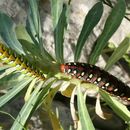Conservation Status
provided by University of Alberta Museums
Introduced species, no concerns.
- license
- cc-by-nc
- copyright
- University of Alberta Museums
Cyclicity
provided by University of Alberta Museums
Adults on the wing late June - July.
- license
- cc-by-nc
- copyright
- University of Alberta Museums
Distribution
provided by University of Alberta Museums
Central and southern Europe. Introduced into western Canada. In Alberta it has apparently become established at a number of locations in the grasslands in the southern part of the province.
- license
- cc-by-nc
- copyright
- University of Alberta Museums
General Description
provided by University of Alberta Museums
A large (6.5 -9.0 cm. wingspan) narrow-winged large-bodied moth. The forewing is light brown with darker brown markings, the paler brown areas speckled with black. Two dark patches extent inward from the costa, and the outer third of the forewing is sharply divided from the rest of the forewing, a dark brown shading outward to light brown. The hindwing is black with a wide rose-pink median band and a narrower terminal band. Very similar to the closely related Bedstraw Hawk-moth (H. gallii), which differs in having a sharply defined black, cream and grey forewing pattern without any speckling in the pale areas, and with the entire costa broadly black. The White-lined Sphinx (H. lineata) has the forewing veins all marked in white.
- license
- cc-by-nc
- copyright
- University of Alberta Museums
Habitat
provided by University of Alberta Museums
Pastures, grasslands and riparian areas infested with Leafy Spurge.
- license
- cc-by-nc
- copyright
- University of Alberta Museums
Life Cycle
provided by University of Alberta Museums
Like other members of the genus, adults are on the wing mainly in the late evening and after dark, and come to light. The Spurge Hawk Moth was introduced at several sites in southern Alberta and Saskatchewan in the late 1960's as a possible biological control for Leafy Spurge. They are now established at a number of sites in southern Alberta (i.e. Medicine Hat and Lethbridge). The larva is a large conspicuous black, red and yellow insect. Its effectiveness as a biological control agent is apparently a very minor one.
- license
- cc-by-nc
- copyright
- University of Alberta Museums
Trophic Strategy
provided by University of Alberta Museums
Members of the Spurge family (Euphorbiae); in Alberta, introduced as a biological control agent for Leafy Spurge (Euphorbia escula L.).
- license
- cc-by-nc
- copyright
- University of Alberta Museums

